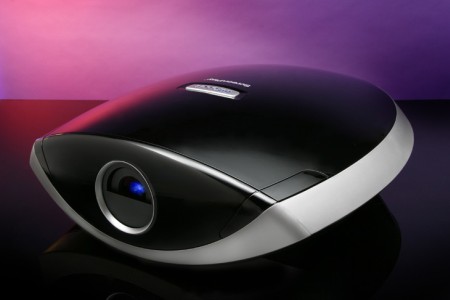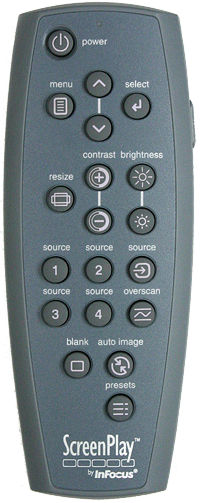InFocus 777 DLP Projector
Triple 7, triple good.
If you ask the average home theater enthusiast to sum up, in one word, the projectors from InFocus, invariably that word would be "bright." Consistently, every InFocus projector we've reviewed has been "the brightest ever," enough so that we don't even bother to say it anymore. So, while the 777 is in fact "the brightest ever," it also possesses something that historically hasn't been an InFocus trait: accuracy. Intrigued? You should be.

The 777 is not, as one might imagine, directly named for the Boeing flying bus. Instead, it is a short way to describe the triplets of 1,280 by 720 digital micromirror devices (DMD, the core of DLP) inside. In a single chip DLP projector, there is-wait for it-one DMD. That type of design creates color by shining light through a rotating color wheel. The biggest benefit is that it is a lot cheaper on the chip front. There are two main drawbacks. The first is the rainbow effect, a smearing of color that some people see, some don't, and others don't care about. This occurs because every color isn't on screen at the same time. As a color on the wheel rotates to shine on the DMD chip, the projector puts that color on the screen. This then happens with the next color, and so on. For the most part, you can't see this happening, but, occasionally, you'll sense this temporal painting. The other main drawback to a color wheel is that the closer you get to accurate color reproduction, the dimmer the picture is. And light output is what sells projectors. InFocus knows this, and that's probably why they sell a billion-trillion of them (not a number, not a sales figure). If cost isn't high on your list of priorities, three-chip systems can fix a number of these problems. In a three-chip DLP system, you have one chip handling each of the three primary colors; red, green, and blue. You don't have to worry as much about the loss of light output. So, you can make it as accurate as you want, and it will still be bright. Take this moment to gander at the measurement box. Sure, it's the brightest projector we've ever measured, but, at the same time, it is pretty much the most accurate, too. How's that for impressive? Keep reading, the review's not over yet.
Setup Install
InFocus expects that you will get a professional to install the projector. This is probably a good idea, as the 777 is awkward to pick up. There are no easy handholds, and it's just heavy enough that you feel like you're going to drop it. That's not a fun feeling if you've just shelled out 15 grand (or more likely $100 a month for the next 15 or so years with interest). In person, the projector is larger than it looks in pictures, and it bares an eerie similarity to the Mark VI torpedo from Star Trek. Keep in mind, I view this as a positive. But, either way, it's a fine-looking projector, though a close-up look reveals the brushed metal-accents to actually be plastic. There are no buttons on the case, which isn't surprising for something intended to be ceiling-mounted. The InFocus logo on the top (or bottom if it's mounted or you're standing on your head) lights a lovely shade of blue. You can turn it off, but compared to the radiance coming off the screen, I doubt you'll notice it.
The remote is the same as the one that comes with most of the rest of the InFocus projector line. In a strange twist, it bares a passing resemblance to the 777 (or perhaps the 777 bares a passing resemblance to it). It is backlit and has programmable direct input access buttons. All and all, it's a good remote.
The menus are the same as that of the 7200 Series. They're easy to navigate and have all the adjustments you, your ISF calibrator, and your installer will ever want.
Yeah, great, get back to how it looks.
To put it simply, this projector will completely ruin every other display for you. Once you get used to watching a huge, bright, accurate picture, you're never going be able to watch anything else. Colors are natural and accurate. While this isn't as flashy as having oversaturated colors, it is significantly more watchable. Skin tones look realistic and healthy. Grass and trees actually look like grass and trees. Like the Samsung SP-H700AE (the only other projector we've done recently that measures this close to accurate), the image is so natural it is almost relaxing to watch. It is easier to get absorbed in what you're watching instead of always thinking in the back of your head that you are watching a TV.
 Light output is bordering on the extreme. Bordering on the far side, that is. At 43.4 foot-lamberts, it is brighter on full white than any plasma we've reviewed, and almost twice as bright as the next closest projector (not surprisingly, an InFocus) since we started measuring contrast ratio. Black level, though, isn't as amazing. At 0.014 ft-L, it is better than any other InFocus and ties with the aforementioned Samsung. For comparison, most high-end DLP projectors hover around 0.003 ft-L. While 0.014 ft-L this isn't terribly dark, there are several reasons why this doesn't matter. First of all, unless you're watching a movie that is exceedingly dark like Master and Commander, any amount of light on the screen is so bright that your iris shrinks down, making the black level in the scene seem plenty dark. In other words, the image pops like an M80 in a coffee can. Second, you can get a neutral density filter adaptor from InFocus that will drop the light output to get the black level you want on your current screen. Lastly, if you want a much lower black level, all it takes is a larger screen. With 43.4 ft-L, you have plenty of sizes to play with. We use an 87-inch-wide, 1.0-gain screen. That's a screen area of 4,263 square feet. A bigger screen would yield a deeper black level. Say you go crazy and double the width (for a movie-theater-sized screen width of 14.5 feet), you'd still have almost 11 ft-L and a corresponding drop in black level-not to mention an entire wall of movie. This extreme example brings up another point. Because the projector is so bright, your room becomes a screen in itself. If your walls, the floor, or anything near the screen is reflective, your onscreen black level is going to go up. Darken your room accordingly, if possible.
Light output is bordering on the extreme. Bordering on the far side, that is. At 43.4 foot-lamberts, it is brighter on full white than any plasma we've reviewed, and almost twice as bright as the next closest projector (not surprisingly, an InFocus) since we started measuring contrast ratio. Black level, though, isn't as amazing. At 0.014 ft-L, it is better than any other InFocus and ties with the aforementioned Samsung. For comparison, most high-end DLP projectors hover around 0.003 ft-L. While 0.014 ft-L this isn't terribly dark, there are several reasons why this doesn't matter. First of all, unless you're watching a movie that is exceedingly dark like Master and Commander, any amount of light on the screen is so bright that your iris shrinks down, making the black level in the scene seem plenty dark. In other words, the image pops like an M80 in a coffee can. Second, you can get a neutral density filter adaptor from InFocus that will drop the light output to get the black level you want on your current screen. Lastly, if you want a much lower black level, all it takes is a larger screen. With 43.4 ft-L, you have plenty of sizes to play with. We use an 87-inch-wide, 1.0-gain screen. That's a screen area of 4,263 square feet. A bigger screen would yield a deeper black level. Say you go crazy and double the width (for a movie-theater-sized screen width of 14.5 feet), you'd still have almost 11 ft-L and a corresponding drop in black level-not to mention an entire wall of movie. This extreme example brings up another point. Because the projector is so bright, your room becomes a screen in itself. If your walls, the floor, or anything near the screen is reflective, your onscreen black level is going to go up. Darken your room accordingly, if possible.
The Rest
Processing is as you'd hope. The projector picked up the 3:2 sequence quickly. Video processing is excellent, with no jagged edges in the flag sequence on the Silicon Optix HQV test DVD. It scales well, though a good aftermarket scaler might be slightly sharper (but not much). There is a little noise in the steps just above black, but it isn't distracting. Otherwise, the image is remarkably noise free. Speaking of noise, the big case also allows for a nicely quiet projector. In our listening room, the setup placed the exhaust near my head, and, amazingly, it wasn't distracting. Mounted on a ceiling, I'd be willing to bet it will be all but inaudible in all but the quietest of movie passages.
Go For It
A year ago this projector would have cost you over $25,000. Now, with a newer generation DMDs inside, it's $10,000 less. While $15,000 for anything but a car is never a bargain, per se, compared to most other high-end single chip DLP projectors, the performance of this one justifies its slightly higher price. The 777 is so accurate, so bright, and so damn good looking that it should be the reference to compare every other projector against-not to mention most other displays. That's distressing to me, as InFocus is eventually going to ask me to send it back. Such is the life of a reviewer. . . .
Highlights
• Tremendous light output
• Excellent contrast ratio
• Nearly perfect color accuracy




























































